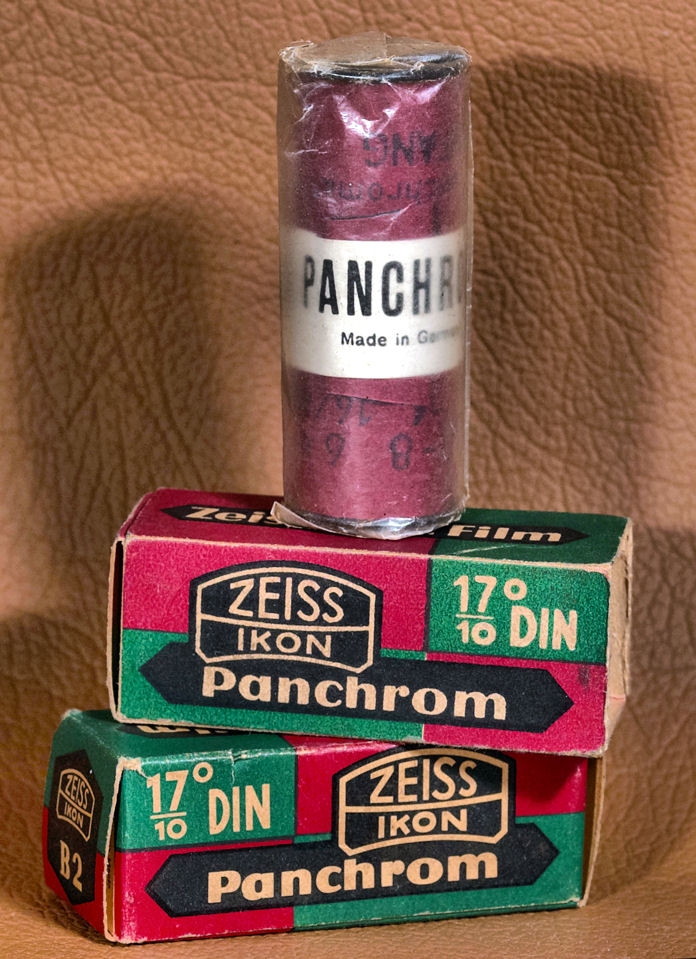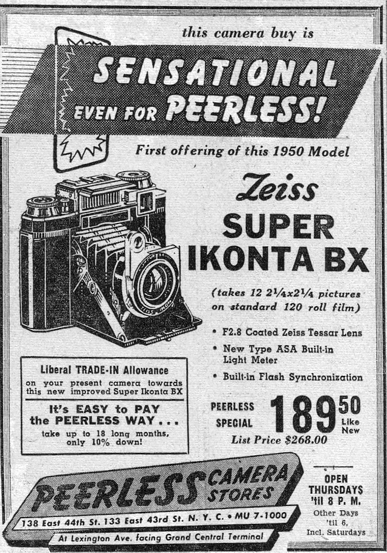Zeiss Ikon Contax Camera Repair
A home for your Zeiss Ikon Contax, Contarex or Super Ikonta camera!
- Home
- Information
- Articles
Index
Super Ikonta Frame Spacing Problems
This is a picture of two rolls of very rare wartime Zeiss Ikon 120 film dated 1944. Zeiss made film for its cameras and you can be absolutely certain that it was designed and made to provide the user with the best possible photographic experience available at that time. It's a shame Zeiss does not make film today.

The occasional Super Ikonta gets sent here for an overhaul every now and then. It is not unusual for the owner to report film frame spacing problems and to ask for the camera to be adjusted to correct this problem. It is unfortunate that there is no possible internal camera adjustment to correct uneven or overlapping frame spacing. The reason for this is that the film advance mechanism contains no provision for adjustment. It's made up of metal gears and latches that are firmly anchored in place. It is possible to completely cut out the interlock in the camera so that frame spacing can be controlled manually and this is discussed later.
The main thing to understand about the Super Ikonta wind control mechanism is that it does not allow the same amount of rotation of the wind knob for each exposure. As film accumulates on the take up spool the spool effectively becomes larger. As the spool accumulates film less and less rotation is required to move a full frames length of film onto the take up spool.
The Super Ikontas were designed to be used with a specific film having a very closely calibrated and controlled thickness. The reason for this is that as the film is wound up on the take up spool the spool diameter increases and as the film accumulates on it less and less rotation of the spool is required to wind a frame length of film on it. Inside the Super Ikonta wind controller is a brass drum. This drum rotates as the film wind knob is rotated. Cut into the side of this drum are slits. After an exposure is made a spring loaded latch is pulled out of its slot in the drum, the wind mechanism is unlocked, and the wind knob is free to rotate. This latch falls into the next slot in line on this drum and locks the film advance mechanism when the film is wound to the next frame. The slits on this drum are cut closer together around the drum to compensate for the increasing diameter of the film take up spool as film accumulates on it.
Inside every Super Ikonta body is a marking to identify the film for which the camera was designed to be used. This marking is either in the form of a label, or it is sometimes embossed into the metal. These are always films made by Zeiss Ikon which are no longer available today. But these identifications go to show that Zeiss built the Super Ikontas to be used satisfactorily only with the films Zeiss made specifically for use with the camera and you can be sure these films were very precisely made.
Since the time the Super Ikontas were made the film available today has become thinner and so has its backing paper. This means that as the film accumulates on the take up spool the spool does not become as thick as the camera was originally designed to use. The result is that some of the film frames will overlap because at the start of the roll the allowed rotation of the take up spool is not enough to advance a full frames length of film.
There are three ways to compensate for this problem:
- Wind up some extra paper on the take up spool and then attach the film leader to this. Or attach a length of extra paper to the end of the film leader with tape. Just how much additional paper to use will have to be found out by experimentation with the particular film you intend to use with the camera. You can experiment by using a pen to mark the edges of the frame on the back of the film backing paper as a test roll of film is run through the camera. Just re spool the film and use it over and over until you find the right length of paper to use. My experiments have taught me that you will need to be very precise in doing this in order to obtain consistent results.
- Wind more of the leader up onto the take up spool before closing the back and releasing the automatic wind latch. The closer you move the double arrows towards the take up spool away from the designated dot the wider the spacing between the closest frames will become.
- With the Super Ikonta models that allow the automatic counter to be reset in mid roll you can simply wind the camera from frame to frame using the red frame number viewing window while resetting the counter for each frame. When the counter is reset this releases the double exposure prevention and allows an exposure to be made.
Here's a German advertisement for Zeiss Ikon film from 1939. It says, "Good Weather Permanox Film, In case of rain it's only right!". The cost of Reich Marks 1.40 per roll in 1939 converts to about $0.56 in 1939 dollars. At that time Gold was $20.00 per ounce and so converting the gold value of $0.56 1939 dollars to today's dollar gold value results in a roll of Permanox costing about $42.00 in the buying power of today's dollars with respect to gold. In 1939 the USA price of a gallon of gasoline was about $0.10 and today its about $3,95 per gallon and this means $0.56 in 1939 dollars is worth about $22.12 today in terms of the price of gasoline. Film has never been cheap.

Here is perhaps the very first printed advertisement for the Super Ikonta BX camera which is still extremely popular today. Notice that the adtertisement has a discounted price for a "Like New" camera. You can be sure that anyone going to the camera store to buy this discounted camera would be told it has already been sold. In 1950 the cost of gold was $32.00 per ounce. This camer cost the equivalent of 8.4 ounces of gold and conerting this to today's price of gold makes the camera price to be roughly $11.348.00. This perhaps explains why no one is manufacturing a Super Ikota BX camera today.

